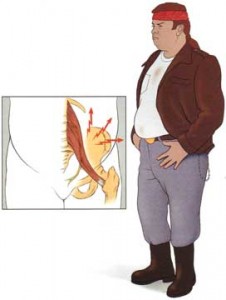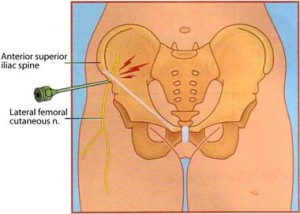Meralgia Paresthetica (MP) is a rare nervous disorder that affects 4 out of every 10,000 people in the country. Find out all about the causes, symptoms, diagnosis, and treatment of the disease.
What is Meralgia Paresthetica?
Page Contents
Meralgia Paresthetics is a condition marked by pain or numbness in the thigh. It involves entrapment of the nerve that extends from the thigh to the spinal column. Simply put, it is caused due to damage or compression of one of the large sensory nerves present in the leg, known as the femoral cutaneous nerve. This nerve is responsible for transmitting sensations from the thigh to the brain. Once this nerve is injured, affected individuals experience extreme burning sensation and pain in their thigh. Pain or numbness may occur in both or only one of the thighs.
The disease is also known as Bernhardt-Roth Syndrome.
Causes of Meralgia Paresthetica
Damage or injury to the femoral cutaneous nerve due to accidents or other factors may result in this syndrome. Such damages are common due to:
Picture 1 – Meralgia Paresthetica
Tight clothing
Wearing tight clothes, belts or braces can put extra pressure or strain on the femoral cutaneous nerve. This may lead to this disorder.
Trauma
An injury to the thigh may also give rise to this nervous ailment.
Surgery
The problem has also been found to occur in some patients after undergoing surgery for cure of various disorders. For instance, the possibility of getting Meralgia Paresthetica is higher after laparoscopic surgery. Similarly other types of surgery, such as those conducted for curing weight loss or heart ailments, may alos lead to this problem.
Medical Conditions
People suffering from diseases like Diabetes or leprosy are prone to this disorder. Similarly, those suffering from diseases like autoimmune disorders (AIDS), back pain, lead poisoning, and knee arthritis are also susceptible to it.
Alcohol consumption
People consuming alcohol are also at increased risk of having this condition.
Anti-rejection medicine
Another common cause of this disorder is the use of anti-rejection medicines, which are mainly implemented in case of transplantation of body organs.
Symptoms of Meralgia Paresthetica
The common signs and symptoms observed in Bernhardt-Roth Syndrome sufferers include:
- Pain on the outer side of the thigh
- Dispersion of pain to other parts of the body, such as knee and buttocks
- Pain, followed by burning sensation in the affected parts
- Increased sensitivity to heat in the affected part. As a result, taking warm shower or accidental spill of warm water produces intense pain in the region.
- Worsening of symptoms after activities, such as walking, that put the thighs under more strain.
Diagnosis of Meralgia Paresthetica
The diagnosis of this disorder involves a number of tests which include:
Blood Tests
Simple blood test may be performed by doctors to analyze the body condition.
Electromyography (EMG)
It is performed to test the functioning of muscles and nerves. In this practice, electrodes are attached near the area that is to be tested. Then, the skin in the region is pierced with some needles. The free end is attached to the electrodes. The activity and functioning of muscles and nerves is recorded by a special device which is connected to the electrode.
Imaging tests
Imaging tests make use of a dye to show up the various body parts and internal structures clearly. Some of the commonly used imaging examinations for this condition involve:
• Computed topography scan
• Magnetic resonance imaging
• Abdominal ultrasound
• X-rays
Prevention of Meralgia Paresthetica
A number of methods can help decrease the possibilities of occurrence of this disorder. These include making simple life style changes and taking precautions, which is possible without the guidance of any medical professional. Some useful preventive methods for this disease are:
Avoidance of alcohol
Drinking alcohol increases the chances of acquiring this disease. Naturally, it should be strictly avoided.
Avoiding tight clothes
You should also avoid tight clothes or belts that put too much pressure or strain on the body parts including the thigh.
Taking weight loss measures
Overweight individuals are at increased risk of getting this disease. If you are obese, you should take proper steps to reduce your body weight. For instance, you may exercise regularly or take help of weight loss medications. You can even take suggestions from your doctor to avoid any complications during the weight loss period.
Keeping sugar levels in check
People having diabetes are also more prone to this disease. Thus, you should take precautionary measures to avoid diabetes or keep sugar in check (if you already have high or low blood sugar).
Treatment of Meralgia Paresthetica
The treatment of this disorder involves use of various curative options, such as:
Picture 2 – Meralgia Paresthetica Image
Drugs
A number of medications are available for treatment of this disease. These involve:
Anesthetics – These are used for controlling painful symptoms associated with the disease. It can either be applied as a patch or administered as an injection.
Antiarrythmics – These are used to control the heart rate of patients and to keep painful symptoms in check.
Anticonvulsants – These are provided to control the seizures associated with this syndrome.
Antidepressants – In some MP patients, depression or sadness is also observed. Antidepressants are prescribed to control such problems.
Non-steroidal Inflammatory Drugs (NSAID) – These are administered to control body pain, inflammation, bleeding and ulcers.
Heat Therapy
The process involves applying moist heat to the affected parts. It relieves pain experienced in the thigh.
Weight loss therapy
Various measures are also taken to ensure reduction of weight in MP patients. These involve use of weight loss recipes, diets or medications. Exercises are also used to help patients increase the strength of their abdominal muscles.
Transcutaneous electric nerve stimulation
It involves the use of a special device for sending signals from the knees to the brain to control the painful symptoms associated with the disease.
Pulsed Radiofrequency
In this method, a special device is used to send electric signals to the affected nerve to make the body able to fight pain.
Surgery
If patients do not respond to the abovementioned practices and medicines, surgery may be required. Operation may involve cutting the tissue near the nerve to relieve it of additional strain.
If treated properly, the condition may be cured in a short time. However, lifestyle management measures such as avoidance of alcohol, tight clothes or trauma should be avoided to ensure complete recovery from the disorder without possibilities of recurrence.
References:
http://www.medicinenet.com/meralgia_paresthetica/article.htm
http://en.wikipedia.org/wiki/Meralgia_paraesthetica
http://orthopedics.about.com/od/hipinjuries/a/meralgia.htm
http://www.livestrong.com/article/311680-outer-thigh-meralgia-paresthetica-exercises/


